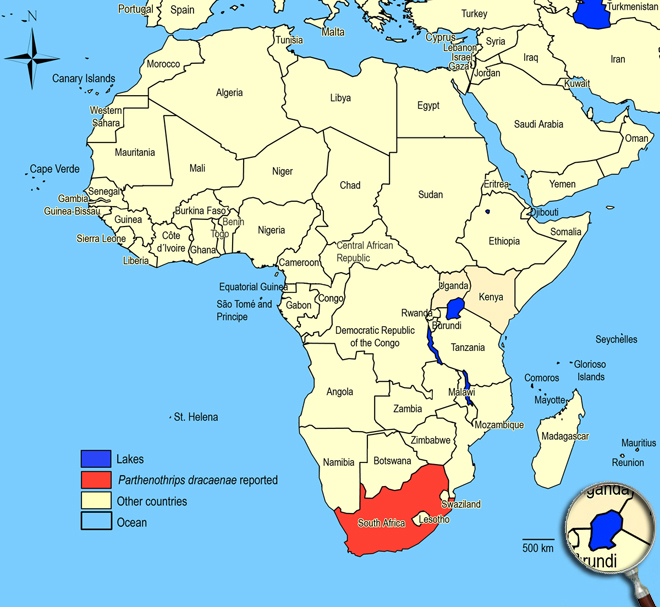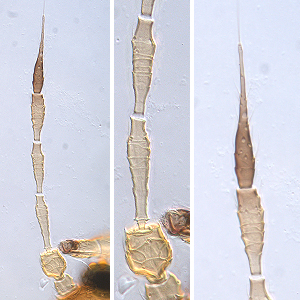Parthenothrips dracaenae (Heeger, 1854)
Panchaetothripinae, Thripidae, Terebrantia, Thysanoptera
Figures
Fig. 1: 7-segmented antenna, pedicel, segments III and IV with simple sense cone, terminal segments V-VII
Fig. 2: Head dorsal with ocellar triangle
Fig. 3: Head dorsal with ocellar triangle
Fig. 4: Pronotum
Fig. 5: Meso- and metanotum
Fig. 6: Meso- and metasternum
Fig. 7: Fore wing and fore wing basal region
Fig. 8: Sternite VII
Fig. 9: Tergites VII and VIII
Fig. 10: Tergites IX-XI
Fig. 11: Adult female feeding on a gum tree leaf
Introduction and recognition
Parthenothrips dracaenae breeds on a wide range of plants, particularly on leaves of the native african succulent shrub Dracaena sp. and Kentia palm (Howea sp). Both sexes fully winged. Body light brown to brown; tarsi and tibiae yellow, also antennal segments I-V; fore wings pale, with small dark cross band in basal half (where first vein fuses to costa) and a more diffuse shaded area on distal half (Fig. 11). Antennae 7-segmented; sense cone on segments III & IV short and simple, VII almost as long as previous segment (Fig. 1). Head reticulate; cheeks parallel sided but constricted to basal neck; vertex with 2 pairs of large but translucent flattened setae (Fig. 2 and 3). Pronotum with 1 pair of large, flattened posteroangular setae; discal area and posterior margin with similar but smaller setae (Fig. 4). Mesonotum not divided medially. Metanotum with median area reticulate; with 1 pair of setae medially and 1 pair of campaniform sensilla (Fig. 5); metafurca elongate and Y-shaped (Fig. 6). Mid and hind tarsi 1-segmented. Fore wing first vein close to or fused to costal vein, fore wing exceptionally broad with constriction in basal third and reticulate membrane; veinal setae broad with thickened median rhachis; costa without cilia; posteromarginal cilia wavy (Fig. 7). Tergites and sternites with broad craspedum; tergites without reticulation medially and weak reticulation laterally, median setae small (Fig. 8 and 9); tergite X with complete median division (Fig. 10). Sternites with 3 pairs of small marginal setae.
Male similar to female but smaller; tergite IX with no strong setae; sternites IV-VII with transverse oblong glandular area, larger on posterior sternites.
Taxonomic identity
Species
Parthenothrips dracaenae (Heeger, 1854)
Taxonomic history
Parthenothrips concolor Uzel, 1895
Thrips dracaenae Regel, 1858
Heliothrips dracaenae Heeger, 1854
Common name
Palm thrips
(This species does not live on any palm plants, it was named originally after Dr. B.T. Palm, Director of Medan Quarantine Station, Indonesia from where the species was first collected and reported from tobacco plants by H. Karny in 1925)
Dracaena thrips
Present taxonomic position
Family: Thripidae Stephens, 1829
Subfamily: Panchaetothripinae Bagnall, 1912
Genus: Parthenothrips Uzel, 1895
Genus description
The genus Parthenothrips Uzel, 1895
There is only one species in this genus. The palm thrips, Parthenothrips dracaenae, is widespread throughout the tropics, and is common on indoor ornamental plants in temperate regions (Mound & Kibby 1998). The body is golden brown with heavy sculpture on the head, legs, thorax and wings. The fore wings are highly distinctive, broad with the reticulate surface pale with one dark band in the basal half and one small shaded area distally, unique amongst all Thripidae.
Species description
Typical key character states of Parthenothrips dracaenae
Coloration and body sculpture
Body color: mainly brown to dark brown
Surface of head, pronotum and fore legs: with heavy, often polygonally reticulate sculpture
Sculptured reticles on head and pronotum: with no internal markings
Antennae
Form of sense cones on antennal segments III and IV: emergent and simple on segments III and IV
Number of antennal segments: 7
Terminal antennal segments: VI-VII forming a single unit
Head
Cheeks shape: constricted to basal neck
Head - occipital ridge dorsally: absent
Head: not prolonged in front of compound eyes
Ocelli: present
Prothorax
Pronotal blotch or pronotal internal apodeme: absent
Pronotum shape: broadly rectangular
Pronotum surface: with mainly equiangular reticulations
Mesothorax
Mesonotum: with an incomplete median division
Metathorax
Metanotum with dominant sculptured triangle medially: absent
Shape of metathoracic furca: elongate and Y-shaped
Wings
Fringe cilia arising: from sockets
Fore wing veins: present
Fore- and hind wing surface: covered with microtrichia
Fore and hind wings: present, more than half as long as abdomen (macropterous)
Apex of fore wing: with prominent terminal setae
Fore wing anterior margin (costal vein): with setae but no cilia
Fore wing costal fringe cilia: arising at anterior margin of wing
Fore wing first vein: close to or fused to costal vein
Fore wing first vein setal row: incomplete, with setae not closely and uniformly spaced
Fore wing second vein setal row: complete, setae uniformly spaced
Fore wing surface: clearly reticulate
Fringe cilia on posterior margin near apex: wavy
Length of fore wing costal setae at middle of wing: longer than half of median wing width
Shape of fore wing apex: with mainly posterior margin curved to join anterior margin
Fore wing extreme apex color: pale
Fore wings: alternating bands of dark and light
Legs
Mid and hind tarsi: with one segment
Color of fore tarsi: pale or yellow, sometimes apical shaded or brown
Abdomen
Tergite II: without specialised cuticle laterally
Tergites IV and V median setal pair: shorter than distance between their bases
Tergite VIII to X: without unusually long and stout setae
Tergites: without distinctive tergal sculpture forming a series of arches on the antecostal ridges
Tergite X: not tubular, longitudinally incomplete
Setae on abdominal tergite X: all setae slender

Similar or related species
The broad, reticulate fore wings that lack fringe cilia on the anterior margin, and the remarkable quill-like major setae on the wings (flattened with prominent rhachis), are highly distinctive of the genus Parthenothrips. Only Retithrips syriacus has wide fore wings but without reticulations and with prominent callosities between costa and anterior vein which is lacking in Parthenothrips.
Biology
Life history
As with other thrips species the life cycle from egg to adult is dependent on temperature. The full cycle can take about 7 days in a greenhouse and 15 days to over a month in outdoor populations and adults may live for more than one month producing several generations in one year depending on seasonal weather (Lewis 1973).
Host plants
Dracaena sp. (Australian palm), Ficus elastica, Howea sp. (Kentia palm) and ornamentals (orchids) in greenhouses.
Vector capacity
None identified, but possible mechanical distribution of phytopathogenic fungi and bacteria.
Damage and symptoms
Larvae and adults feed on mature leaves rather than young leaves, and pupae also occur on leaves. Feeding on a wide range of plants, most of which have hard leaves. Palm thrips causes typical direct damage on leaves of host plants - silver areas that violate aesthetic appearance of ornamental plants (Trdan et al. 2005).
Detection and control strategies
-
Additional notes
When found this thrips is slow moving sometimes requiring prodding with a fine paint brush to stimulate flight.
Palm thrips is the first species from the Thysanoptera order that was found to be capable for thelytokous parthenogenetic reproduction. This characteristics is contained in the latin name of the genus. Populations are almost completely composed of females at the temperatures from 25-28°C, while a few males can be found at the lower temperatures (18-20°C) (Lewis 1973).
Biogeography
Worldwide distributed in greenhouses on ornamental plants and found in outdoor populations in the tropics and subtropics. South Africa (KwaZulu-Natal: Durban; Western Cape: Wynberg).
African countries where Parthenothrips dracaenae has been reported

The species Parthenothrips dracaenae was not observed in surveys undertaken in East Africa on vegetables and associated weeds and crops.
Please click here for survey sites of all observed thrips species of Kenya, Tanzania and Uganda.

Bibliography
Bailey SF (1957). The thrips of California Part I: Suborder Terebrantia. Bulletin of the California Insect Survey. 4 (5): 143-220
Heeger E (1854). Beiträge zur Naturgeschichte der Insecten Österreichs. Sitzungsberichte der Kaiserlichen Akademie der Wissenschaften in Wien, Mathematisch-Naturwissenschaftliche Classe. 14 (3): 365-373
Lewis T (1973). Thrips: their biology, ecology and economic importance. Academic Press Inc., London Ltd., 349 pp.
Lewis T (1997). Thrips as crop pests. CAB International, Wallingford, 740 pp
Moritz G (2006). Thripse. Pflanzensaftsaugende Insekten, Bd. 1, (1. Auflage). Westarp, Hohenwarsleben, 384 pp. ISBN-13: 978 3 89432 891 7
Moritz G, Morris DC & Mound LA (2001). ThripsID - Pest thrips of the world. ACIAR and CSIRO Publishing Collingwood, Victoria, Australia, CDROM ISBN 1 86320 296 X
Moritz G, Mound LA, Morris DC & Goldarazena A (2004). Pest thrips of the world - an identification and information system using molecular and microscopical methods. Centre for Biological Information Technology, University of Queensland, Australia, CDROM ISBN 1 86499 781 8
Moritz G, O'Donnell C & Parrella M (2009). Pest thrips of North America. Centre for Biological Information Technology, University of Queensland, Australia, CDROM ISBN-13: 978 1 86499 940 2
Mound LA & Kibby G (1998). Thysanoptera: An identification guide, (2nd edition). CAB International, Wallingford and New York, 70 pp
Mound LA & Marullo R (1996). The thrips of Central and South America: An introduction (Insecta: Thysanoptera). Memoirs on Entomology, International, Vol. 6. Associated Publishers, Gainsville, 487 pp
Palmer JM, Mound LA & du Heaume GJ (1989). 2. Thysanoptera, 73 pp. In Betts CR [ed.], CIE Guides to insects of importance to man. CAB International, Wallingford, Oxon, UK
Sakimura K (1953). Parthenothrips dracaenae, a non-vector of the spotted wilt virus. Journal of Economic Entomology. 46 (2): 287-287
Stannard LJ (1968). The thrips, or Thysanoptera, of Illinois. Illinois Natural History Survey Bulletin. 29 (4): 215-552
Staub PF (1979). Post-embryonic development of the nervous-system of Parthenothrips dracaenae Heeger (Thysanoptera, Terebrantia). Revue Suisse de Zoologie. 86 (2): 367-394
Trdan S, Jovic M & Andjus L (2005). Palm thrips, Parthenothrips dracaenae (Heeger) (Thysanoptera: Thripidae), in Slovenia: still a pest of minor importance? Acta Agriculturae Slovenica. 85 (2): 211-217
Uzel H (1895). Monographie der Ordnung Thysanoptera. Uzel, Königgratz, 473 pp
Wilson TH (1975). A monograph of the subfamily Panchaetothripinae (Thysanoptera: Thripidae). Memoirs of the American Entomological Institute. 23: 1-354
zur Strassen R (2003). Die terebranten Thysanopteren Europas und des Mittelmeer-Gebietes. Die Tierwelt Deutschlands und der angrenzenden Meeresteile nach ihren Merkmalen und nach ihrer Lebensweise, 74. Teil. Goecke & Evers, Keltern, Germany, 277 pp
----
Web links
Mound´s Thysanoptera pages
Thysanoptera Checklist
ICIPE Thrips survey sites
UNI Halle & Thrips sites
Thrips of California














